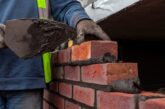
Angus Crichton, Marketing Manager at ACO House and Garden, speaks with Rupert Keys, founder of landscaping training centre, TASK Academy about best practise when installing ground reinforcement tiles.
Grass and gravel are classic choices for landscaping. The lush expanse of a lawn and the gratifying crunch of gravel underfoot are practically unbeatable. But, if regularly crossed by people or vehicles, grass becomes a muddy track, gravel scatters and moving anything wheeled across it is hard work.
Ground reinforcement grids provide a solution. These grids distribute weight directly to the underlying ground, safeguarding the grass and preventing ruts. The honeycomb cells lock gravel in place, reducing scatter and improving access. Gravel and grass supported by grids can be used on front driveways to disperse rainwater where it lands, which is both a legislative requirement and has a positive environmental impact, as rainwater runoff contributes to sewage overflows.
Consequently, I sought expert advice from Rupert Keys on the proper installation of ground reinforcement tiles. Rupert is the founder of landscaping training centre TASK Academy and has been involved in the creation of over 60 show gardens during his more-than 34 years in the landscaping industry. Here’s what he advises:
1. Test the ground

The first thing that you’re going to want to do is test the ground you’re going to be excavating out because you don’t know how solid it is, and not just on the surface. This can have an impact on the depth of the sub-base required. A trial pit or a core sample will reveal if the sandy soil on the surface turns to clay 300mm down.
If you send a soil sample to the lab for a California Bearing Ratio Test, you can find out the compaction properties of the soil. You can then adapt the depth of sub-base in accordance with the soil conditions below, as well as allowing for the weight of traffic above. It’s always useful to get a structural engineer involved, and choose a grid that is the right strength for what is expected to travel over it.
2. Build a secure sub-base
Having a secure sub-base is relatively straightforward and is an important part of the project’s stability and longevity. I always keep three rules in mind when creating a secure sub-base:
Rule 1: Free-draining layers. To stabilise the soil and ensure permeability to the surface water above, put down MOT Type 3. This open-graded sub-base material has reduced fines, which increases its permeability, yet compacts tightly for load bearing.
Rule 2: Separate the layers. Sandwich the MOT Type 3 between two layers of geotextile membrane. The geotextile stops soil coming up into the sub-base and stone moving down into the soil. Without a membrane, you’ll get insects and worms bringing up soil into MOT Type 3 and clogging up its permeable spaces, and stone travelling down, causing sinking.
Rule 3: Lay and compact layers in stages. Sub-bases should be compacted in layers of no more than 75mm in depth at a time. You don’t want to be compacting 200mm of sub-base all in one go because the compaction is not getting down to the bottom. It’s just going to sink when trafficked.
3. Lay the tiles
You might find that your finished MOT Type 3 is undulating, so I use a thin blinding of sharp sand (or more free-draining grano dust) over the top of the MOT just to take out any dips or hollows. Having compacted this laying course, the grids go down on top of that in a stretcher pattern, breaking up joints between rows like with brickwork.
This is all after we’ve laid some edgings. These retain the gravel, hold everything in place and stop spread, particularly when a vehicle turns. You could use nice block paving, concrete curbs, or solid metal edging. If grids are installed on a slope, pin them into the ground.
4. Finish with gravel or grass

For gravel, you would probably lay something between 10-14mm. You don’t want anything too big as you want that gravel to sit in the honeycomb effect of the grid system. For grass, add and level off soil into the grids and then sow. Make sure it is good quality topsoil, without any compost, firmed down but not over-compacted so the roots bind all that soil together. If it is dry, water the grass a couple of times a week until it is established.
How can construction professionals learn more?
Rupert founded TASK Academy to share his extensive experience with students, aiming to inspire younger generations to pursue landscaping. At ACO, we support TASK Academy as an industry partner, helping to enhance the skills of future landscapers. Those interested in a practical landscaping course led by industry experts can find more information on the TASK Academy website: Landscaping courses & training | Task Academy
For more information on ACO ground reinforcement tiles visit ACO.co.uk







